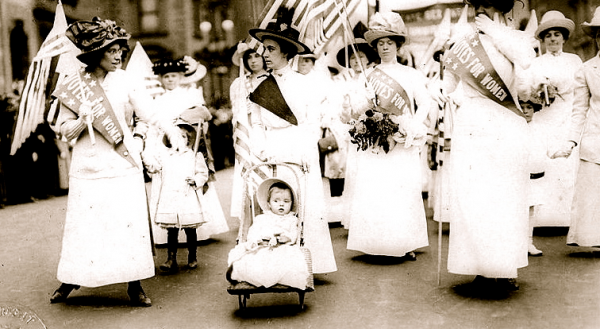The right of citizens of the United States to vote shall not be denied or abridged by the United States or by any State on account of sex. Congress shall have power to enforce this article by appropriate legislation. [19th Amendment, U.S. Constitution]
The nineteenth amendment to our Constitution is terse and straightforward. The language adopted on August 18, 1920 does not grant rights. (As the Constitution gives states the right to determine voting qualifications, some states had already granted women the right to vote.) It prohibits the restriction of voting rights based on gender.
Its necessity was required because of a Supreme Court ruling, Minor v. Happersett, in 1875. The Court agreed that women were granted citizenship under the Constitution but denied that all citizens, in this case women, could be assumed to have the right to vote simply by virtue of their citizenship.
Throughout the history of our country, some women had been outspoken about women’s rights. When the Constitution was under consideration, Abigail Adams petitioned her husband John to include rights for women in the document, but her words fell on fallow ground. The Constitution left the decisions about which citizens were eligible to vote to the states and all but New Jersey, denied that right to a women. (New Jersey later revoked that privilege in 1807.)
In June 1848, the Liberty Party, even though it was all male, wrote a plank in their presidential campaign platform, calling for women’s suffrage. One month later, at a women’s rights convention in Seneca Falls, New York, women demanded suffrage.
Perhaps Francis Minor, a suffrage leader in Missouri, was growing impatient when she attempted to register to vote on October 15, 1872. Turned away because she was a woman, she engaged her favorite lawyer, her husband, Francis Minor, to bring action against the local county. He argued that the Constitution assured the right to vote when it granted women citizenship. The courts, up to and including the Supreme Court, found fault with this logic and denied a woman’s right to participate in democracy.
By this time women’s suffrage leaders were popping up like iris in springtime and, as independent-minded souls moved West, the early territories, and later states, were early adopters of voting rights for women. Both Wyoming Territory and Utah had granted women the right to vote before Minor v. Happersett (Wyoming in 1869 and Utah in 1870). Organization at state and national levels began to make inroads. In 1878, Susan B. Anthony and Elizabeth Cady Stanton drafted the nineteenth amendment. Meanwhile, back at the ranch, Washington Territory granted women (including black women) the right to vote in 1881. Colorado and California followed in 1893 and Idaho in 1896. Oregon approved suffrage for women in 1912, after defeating the measure five times.
Susan B. Anthony’s amendment was submitted to Congress repeatedly over the forty-one years it took for Congress to submit the amendment to the states for ratification. Even then it might not have been approved if President Wilson had not strong-armed Congress and called a special session to consider suffrage. Illinois, Wisconsin, and Michigan, all sitting in session, ratified the amendment within days. Tennessee was the last state to approve the amendment when 50 of its 99 representatives voted yes.
After the amendment passed, the remaining twelve states voted to ratify the amendment but eight Southern states did not do so until 1952 or later. Mississippi was the last state to ratify the amendment—in 1984.


This article tries to correct history and gives due to those who helped women obtain the vote in Wyoming. We know that many men are responsible for assisting “first women” and respect their contribution. There is also a good history of Esther Morris (my Woman of Note from August 8) in this article.